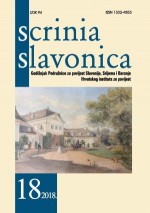Danica Pinterović, Oscar Nemon i spomenik osječkim i slavonskim Židovima – žrtvama Holokausta
Danica Pinterović, Oscar Nemon and the Monument to the Jews of Osijek and Slavonia – the Victims of the Holocaust
Author(s): Daniel ZecSubject(s): Jewish studies, Museology & Heritage Studies, Visual Arts, Social history, Recent History (1900 till today), History of the Holocaust
Published by: Hrvatski institut za povijest
Keywords: Oscar Nemon; Danica Pinterović; Osijek; sculpture; Monument to the victims of fascism; Jews; Holocaust;
Summary/Abstract: The main topic of this paper is the history of the Monument to the Jews of Osijek and Slavonia, the victims of the Holocaust, from idea to erection. The work of the sculptor Oscar Nemon (1906-1985), the monument was erected in 1965 in Osijek and Danica Pinterović, PhD, historian and head of the Museum of Slavonia in Osijek, played a significant, if not the key, role in its being put up – as an expert adviser, whose opinion was in demand and appreciated, as a mediator and as a person involved in its realization. However, the outward form of the monument did not comply with the image the artist had in mind – the size should have been much larger. Instead, the maquette, i.e. the plaster model of the monument – the sculpture made by Nemon in his studio in England, a sculpture somewhat larger than life size – was cast in bronze and placed in Osijek. The sculpture has the form of a slender pillar developing into the bust of a mother holding up her child. The symbolism is explained by the artist himself: “My sculpture does not represent a judgemental view, quite the contrary; it is a figure expressing enthusiasm and vitality symbolizing the never-ending yearning of the Jews for philanthropy. The symbol of motherhood is a symbol understood throughout the world.” The monument was Nemon’s donation to the city of Osijek – Nemon made it at the invitation of the Jewish Community of Osijek and dedicated it in form of a plaster model to his hometown. It was placed in front of the Jewish Community Centre of Osijek. The interpretation of the meaning of this monument in Osijek raises the following questions: why was it erected, to whom was it dedicated and what message did convey? The Holocaust of the Jews of Osijek and Slavonia was the reason why this monument was erected – it was primarily a dedication to them and its message was love, that is to say, philanthropy, as stated by the author. Nevertheless, from the very beginning the local newspapers tried to equivocate, in their public correspondence, concerning the information to whom the monument was dedicated; hence the interpretation of the meaning of the monument varied between the war sufferings of the Jews and the universal victims of fascist terror. Nemon’s sculpture was, eventually, put in place, unveiled and read as a monument to the victims of fascism. The reasons for such a presentation and the interpretation of the meaning of this monument were understandable considering the historical-political context of the period in which it was made – the suffering of the Jews in the Holocaust was at that time presented as part of the same tragic fate that the other nations and ethnicities of Yugoslavia had shared. On the other hand, the modified interpretation of the Osijek monument raises the issue of the society facing the heritage of the Holocaust that was hard to bear, as witnessed by the way in which the Tenja Jewish Camp not far from Osijek was commemorated (it was the Ustasha concentration camp from which the Jews from Osijek and the surrounding area were deported to extermination camps in 1942; on the monument there is no mention of this). Today the “Mother and Child” Monument of Osijek should be interpreted unambiguously and without generalization, precisely as it was intended – as a monument to the Jews of Osijek and Slavonia, the victims of the Holocaust. Furthermore, in the Republic of Croatia this monument is the only sculpture established in a public city area – all other monuments dedicated to the Holocaust are established, almost without exception, on Jewish cemeteries. This paper is concerned with scholarship and publications of Danica Pinterović dedicated to the sculptor Oscar Nemon. The first scholarly articles on Oscar Nemon were published by Danica Pinterović in the Encyclopaedia of Fine Arts, 1964, and a more comprehensive scholarly text in the scholarly journal “Osječki zbornik” in 1967 in which she referred to significant biographical data and the chronology of Nemon’s art work. Later authors, studying Nemon’s biography and opus, to a great extent, drew on the text of Danica Pinterović as the foundation for their own considerations and contributions to Nemon’s biography on his life and art.
Journal: Scrinia Slavonica
- Issue Year: 2018
- Issue No: 18
- Page Range: 405-428
- Page Count: 24
- Language: Croatian

